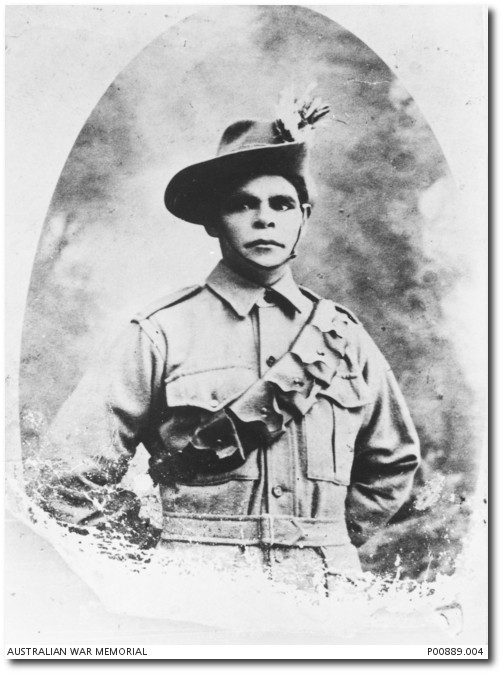
Studio portrait of Private Harry C Murray, 11th Light Horse Regiment. Courtesy Australian War Memorial, Accession P00889.004
Indigenous Australian, Harry MURRAY, 11th Light Horse Regiment
Harry (Henry) Murray was born in 1884 at Hornet Bank Station, on the upper Dawson River, now infamously known as the site of the 1857 massacre. His father George Pulteney Malcolm Murray was born in Scotland, an officer with the Native Police, and his mother an Aboriginal woman from Taroom, who died when Harry was very young.
Murray enlisted to serve with the first AIF in July 1917 at Mitchell, having been granted exemption from the Queensland Aboriginal Protection Act that same year. He initially trained at the Rifle Range Camp, Enoggera before embarking with a number of other Indigenous enlistments with the 20th Reinforcements for the 11th Light Horse Regiment, in December 1917 on board HMAT Ulysses.
Murray was admitted to the ships hospital during the voyage with laryngitis and when they arrived at the Port of Suez he was admitted there to a hospital with mumps. He joined his fellow recruits at the Reinforcements camp at Moascar in January 1918 and after several months returning to strength, they joined the Regiment in the field at Belah, Palestine in March 1918.
In August 1918 Murray was evacuated from the field and admitted to a Casualty Clearance Station. The records show NYD [not yet diagnosed], which was generally a fever - and most likely malaria. Harry did not return to his unit until 11th November 1918, the day of the European armistice.
Murray returned to Australia with the other members of the 11th Light Horse Regiment after being deployed to quell the Egyptian uprising of 1919 in protest of English rule, arriving home in July 1919 on board the troopship 'Morvada'.
Having already been granted exemption from the Protection Act, Murray readily found work again on Womblebank Station, and was granted the War Gratuity Bond. Murray remained in the Maranoa region, working as a stockman for many years, he died in 1965.
Read more ...
- Service record: MURRAY, Henry
- Embarkation roll: 20th Reinf. 11th Light Horse Regiment
- Hornet Bank massacre. Wikipedia
- Mitchell Police Letterbook 1889-1921
- From Hornet Bank to Cullin-La-Ringo by Gordon Reid, 1981
- One of the soldiers featured in SLQ’s HistoryPin Collection
- Queensland’s Indigenous Servicemen Digital Story and Oral History
The information in this blog post has been researched by State Library staff and volunteers, it is based on available information at this time. If you have more information that you would like to share or further research uncovers new findings, this post will be updated.
Comments
Your email address will not be published.
We welcome relevant, respectful comments.